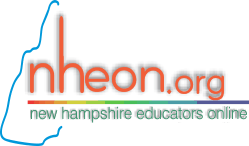|
Digital Literacy Research |
Technology in Education Research Basis
Supporting the integration of technology into teaching and learning for next generation college and career ready students . |
Some current research in Educational Technology can be found at:
Below is an historical account of research which informed ICT Literacy Standards for New Hampshire. A lot of this information is no longer available online. But it gives an idea of the kinds of thought that went into ICT Literacy, now termed Digital Literacy.
Center for Applied Research in Educational Technology (CARET), was managed by ISTE, and an excellent website for research about educational technology. A search for some useful questions about technology literacy
yielded the following answers. Use the question links
to view the research evidence used to answer each question:
Q:
How can technology influence student academic performance?
A: The
CARET site answers "Technology improves performance
when the application provides opportunities for students
to design and implement projects that extend the
curriculum content being assessed by a particular
standardized test."
Q:
How can technology develop higher order thinking
and problem solving?
A:CARET indicates " Technology
can enable the development of critical thinking skills
when students use technology presentation and communication
tools to present, publish, and share results of projects."
American
Association of School Administrators. (n.d.). Preparing
Schools and School Systems for the 21st Century. Arlington, VA.
This study points out 16 major characteristics
of schools and school systems capable of preparing students
for a global knowledge/information age:
“In the 21st century, schools
will become nerve centers, with walls that are porous
and transparent connecting teachers, students and
the community to the wealth of knowledge that exists
in the world, Schools in the 21st century will not
be confined by their walls but will be encompassing
of the entire community and the world…. [They
will become] digital hubs, which will be open electronically
24-hours-a-day, 7-days-a-week, 365-days-a-year…”
Colburn, L.K.
(2002, February). Integrating laptops into multiple subject areas: Thoughts from
teachers and students. Reading Online, 5(6).
This
article presents some interesting ideas about how tech
literacy should be part of a school literacy curriculum.
The Reading Online journal contains several pertinent
articles in the archives of past issues.
Hewett, S. (2004, September). Improving
Instructional Practices. TechTrends: Linking Research & Practice
to Improve Learning, 48(5), 26-30.
This article describes three basic types
of portfolios and outlines implementation of digital
portfolios within a teacher education program.
Higgins, C. (2007). Digital portfolios in middle school: A phenomenographic study
of student engagement and achievement. Doctoral
dissertation, Argosy University, Sarasota, 2007.
This study was conducted within New Hampshire
middle schools during the 2006-07 academic year. Its
purpose was to examine how the development of digital
portfolios by middle school students impacts student
engagement and student achievement. Data collection,
using a mixed methods approach, included interviews
of six eighth grade students, content analysis of eighteen
student portfolios, and the use of secondary source
data from state assessment reports and from the My
Voice Student Aspirations Survey. T-tests were used
to compare the assessment and survey data between twenty-three
portfolio and non-portfolio schools. Content analysis
was used to analyze portfolio data using a category-coding
procedure. The absence of schools with robust portfolio
processes in place at the time of the study made it
necessary to adjust the definition of portfolio schools
for purposes of the quantitative portion of the study.
Results of the quantitative data analysis indicated
no significant difference between portfolio and non-portfolio
schools, while qualitative data revealed strong evidence
that digital portfolios have a positive impact on student
engagement.
Kelly, M.G., Haber, J. (2006). National educational technology standards for students: Resources
for student assessment. Eugene, OR: International Society for Technology in Education.
This is an excellent resource on the
variety of resources on student assessment available,
as well as the unique considerations that should be
addressed when implementing different types of assessments.
McNabb, M.,
Cradler, J., Freeman, M., & Cradler,
R. (2002, November). On the horizon: electronic student performance assessments
for higher-order thinking. Learning and Leading with
Technology, 30(3). p50(5).
The authors present many
valuable ideas which deserve to be quoted:
“Assessment-centered lessons,
units, or projects require teachers to identify learning
outcomes and to explicitly link all lesson components,
criteria, and rubrics for assessing what students
are learning. Additionally, programs with embedded
assessments can provide students and teachers with
immediate feedback about what is being learned....
Methods for using technology to expand the domains
of what can be measured, however, are emerging. For
example, networked environments provide ways to measure
individual and team performance strategies in problem-solving
simulations. Students can use digital authoring tools
as simple as Inspiration and HyperStudio to demonstrate
their mental maps of relationships among facts, concepts,
and processes."
Moersch, C. (2002). Beyond Hardware: Using Existing Technology to Promote Higher-Level
Thinking. Eugene, OR: International Society for
Technology in Education. -- Dr. Chris Moersch is the
author of the LoTi assessment survey used across New
Hampshire. His book provides a framework for using
existing technology to develop and revise lesson plans
that promote critical thinking skills.
Second Information Technology in Education Study: Module 2
(SITES: M2) is an international study of innovative pedagogical
practices that use information and communication technology
(ICT).
|



